Analytical Thinking & Decision Making: SMART Technique in Business
VerifiedAdded on 2024/05/16
|14
|4300
|171
Report
AI Summary
This report discusses the importance of decision-making skills and the application of decision analysis, focusing on Tesco as an example. It identifies a decision problem related to business expansion and applies the Simple Multi-Attribute Rating Technique (SMART) to analyze the problem. The report clearly defines each stage of the analysis and presents the strengths and limitations of the analysis in the context of Tesco's decision problem, highlighting the importance of rational decision-making for achieving organizational goals and fostering innovation, while also acknowledging potential challenges and disruptions to stakeholders.
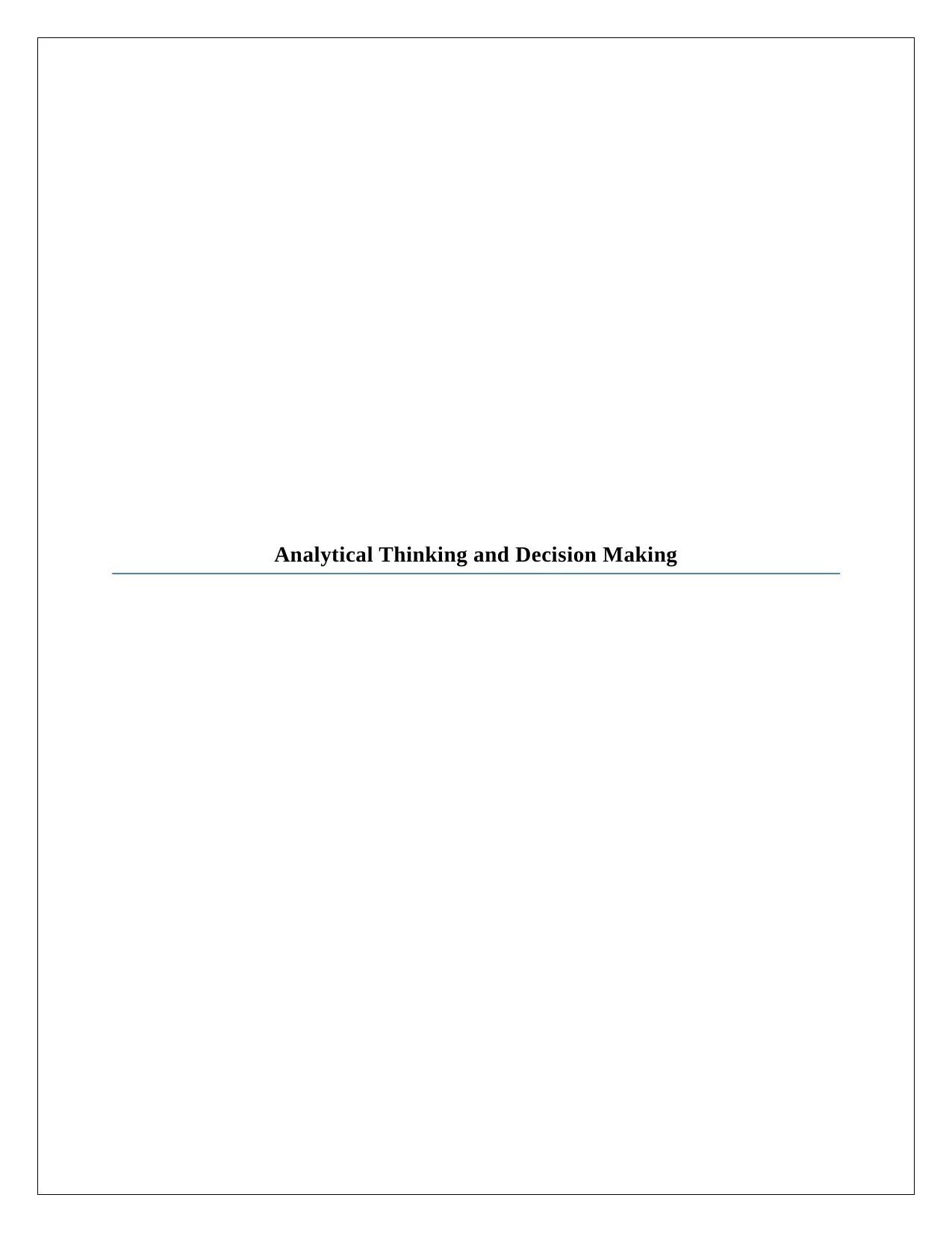
Analytical Thinking and Decision Making
Paraphrase This Document
Need a fresh take? Get an instant paraphrase of this document with our AI Paraphraser

Table of Contents
Introduction......................................................................................................................................3
Discuss the importance of decision making and the application of decision analysis....................4
Identify and outline a decision problem relating to your work or an external organisation, which
involves multiple objectives............................................................................................................6
Apply the simple multi-attribute rating technique (SMART) to the outlined decision problem.
Each stage of the analysis should be clearly defined and presented................................................8
Discuss and detail the strengths and limitations of your analysis in the context of your decision
problem..........................................................................................................................................11
Conclusion.....................................................................................................................................13
Reference List................................................................................................................................14
Introduction......................................................................................................................................3
Discuss the importance of decision making and the application of decision analysis....................4
Identify and outline a decision problem relating to your work or an external organisation, which
involves multiple objectives............................................................................................................6
Apply the simple multi-attribute rating technique (SMART) to the outlined decision problem.
Each stage of the analysis should be clearly defined and presented................................................8
Discuss and detail the strengths and limitations of your analysis in the context of your decision
problem..........................................................................................................................................11
Conclusion.....................................................................................................................................13
Reference List................................................................................................................................14
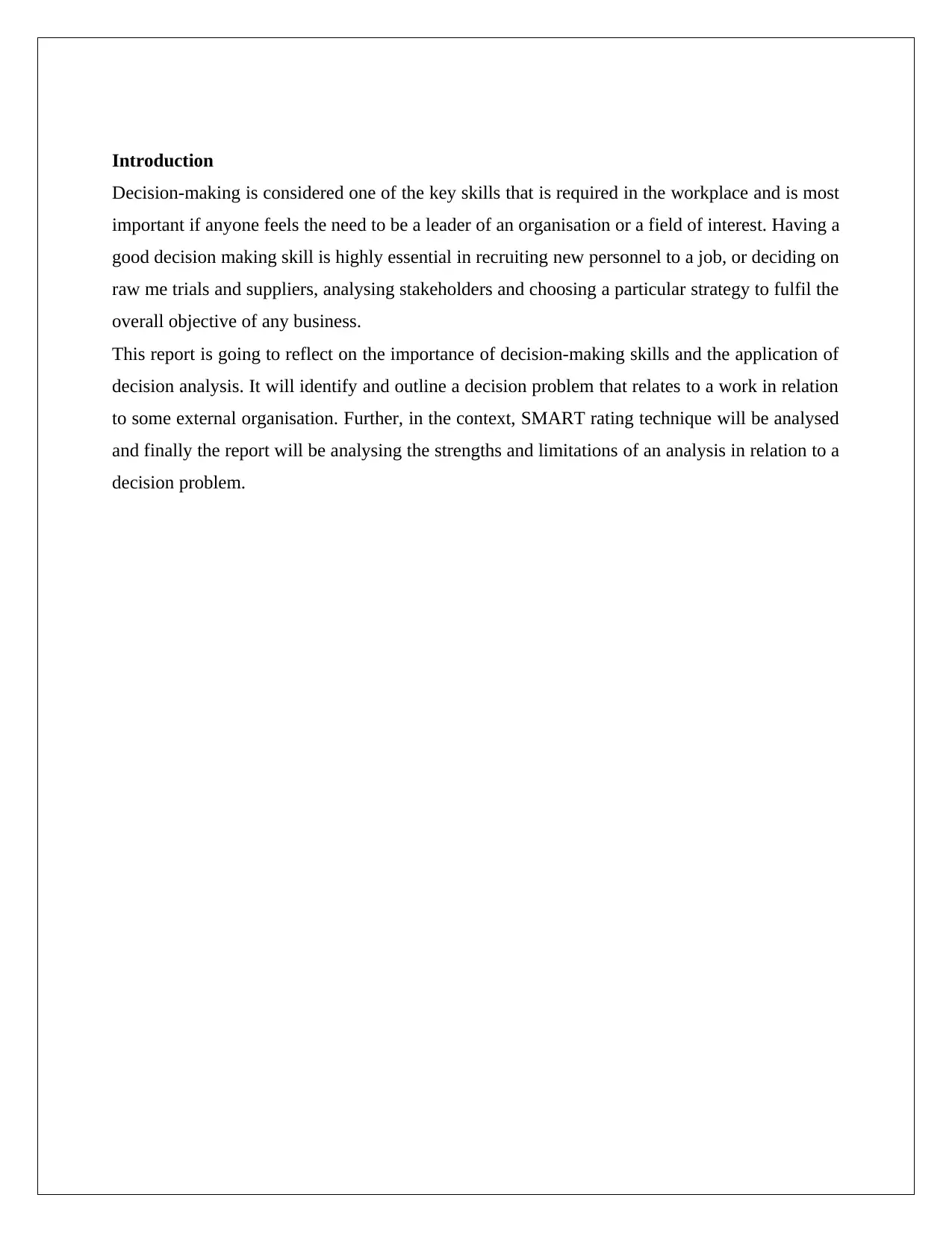
Introduction
Decision-making is considered one of the key skills that is required in the workplace and is most
important if anyone feels the need to be a leader of an organisation or a field of interest. Having a
good decision making skill is highly essential in recruiting new personnel to a job, or deciding on
raw me trials and suppliers, analysing stakeholders and choosing a particular strategy to fulfil the
overall objective of any business.
This report is going to reflect on the importance of decision-making skills and the application of
decision analysis. It will identify and outline a decision problem that relates to a work in relation
to some external organisation. Further, in the context, SMART rating technique will be analysed
and finally the report will be analysing the strengths and limitations of an analysis in relation to a
decision problem.
Decision-making is considered one of the key skills that is required in the workplace and is most
important if anyone feels the need to be a leader of an organisation or a field of interest. Having a
good decision making skill is highly essential in recruiting new personnel to a job, or deciding on
raw me trials and suppliers, analysing stakeholders and choosing a particular strategy to fulfil the
overall objective of any business.
This report is going to reflect on the importance of decision-making skills and the application of
decision analysis. It will identify and outline a decision problem that relates to a work in relation
to some external organisation. Further, in the context, SMART rating technique will be analysed
and finally the report will be analysing the strengths and limitations of an analysis in relation to a
decision problem.
⊘ This is a preview!⊘
Do you want full access?
Subscribe today to unlock all pages.

Trusted by 1+ million students worldwide
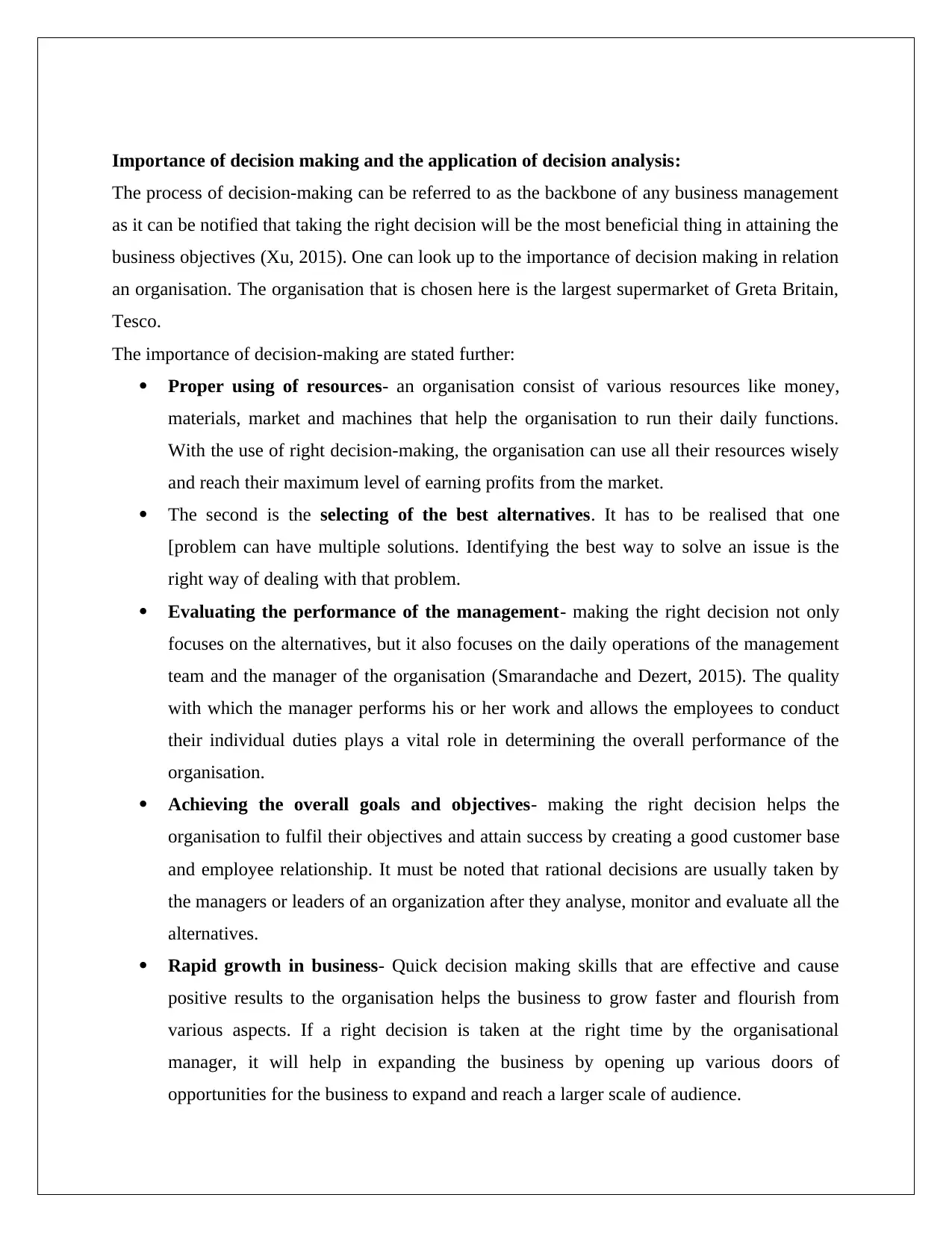
Importance of decision making and the application of decision analysis:
The process of decision-making can be referred to as the backbone of any business management
as it can be notified that taking the right decision will be the most beneficial thing in attaining the
business objectives (Xu, 2015). One can look up to the importance of decision making in relation
an organisation. The organisation that is chosen here is the largest supermarket of Greta Britain,
Tesco.
The importance of decision-making are stated further:
Proper using of resources- an organisation consist of various resources like money,
materials, market and machines that help the organisation to run their daily functions.
With the use of right decision-making, the organisation can use all their resources wisely
and reach their maximum level of earning profits from the market.
The second is the selecting of the best alternatives. It has to be realised that one
[problem can have multiple solutions. Identifying the best way to solve an issue is the
right way of dealing with that problem.
Evaluating the performance of the management- making the right decision not only
focuses on the alternatives, but it also focuses on the daily operations of the management
team and the manager of the organisation (Smarandache and Dezert, 2015). The quality
with which the manager performs his or her work and allows the employees to conduct
their individual duties plays a vital role in determining the overall performance of the
organisation.
Achieving the overall goals and objectives- making the right decision helps the
organisation to fulfil their objectives and attain success by creating a good customer base
and employee relationship. It must be noted that rational decisions are usually taken by
the managers or leaders of an organization after they analyse, monitor and evaluate all the
alternatives.
Rapid growth in business- Quick decision making skills that are effective and cause
positive results to the organisation helps the business to grow faster and flourish from
various aspects. If a right decision is taken at the right time by the organisational
manager, it will help in expanding the business by opening up various doors of
opportunities for the business to expand and reach a larger scale of audience.
The process of decision-making can be referred to as the backbone of any business management
as it can be notified that taking the right decision will be the most beneficial thing in attaining the
business objectives (Xu, 2015). One can look up to the importance of decision making in relation
an organisation. The organisation that is chosen here is the largest supermarket of Greta Britain,
Tesco.
The importance of decision-making are stated further:
Proper using of resources- an organisation consist of various resources like money,
materials, market and machines that help the organisation to run their daily functions.
With the use of right decision-making, the organisation can use all their resources wisely
and reach their maximum level of earning profits from the market.
The second is the selecting of the best alternatives. It has to be realised that one
[problem can have multiple solutions. Identifying the best way to solve an issue is the
right way of dealing with that problem.
Evaluating the performance of the management- making the right decision not only
focuses on the alternatives, but it also focuses on the daily operations of the management
team and the manager of the organisation (Smarandache and Dezert, 2015). The quality
with which the manager performs his or her work and allows the employees to conduct
their individual duties plays a vital role in determining the overall performance of the
organisation.
Achieving the overall goals and objectives- making the right decision helps the
organisation to fulfil their objectives and attain success by creating a good customer base
and employee relationship. It must be noted that rational decisions are usually taken by
the managers or leaders of an organization after they analyse, monitor and evaluate all the
alternatives.
Rapid growth in business- Quick decision making skills that are effective and cause
positive results to the organisation helps the business to grow faster and flourish from
various aspects. If a right decision is taken at the right time by the organisational
manager, it will help in expanding the business by opening up various doors of
opportunities for the business to expand and reach a larger scale of audience.
Paraphrase This Document
Need a fresh take? Get an instant paraphrase of this document with our AI Paraphraser
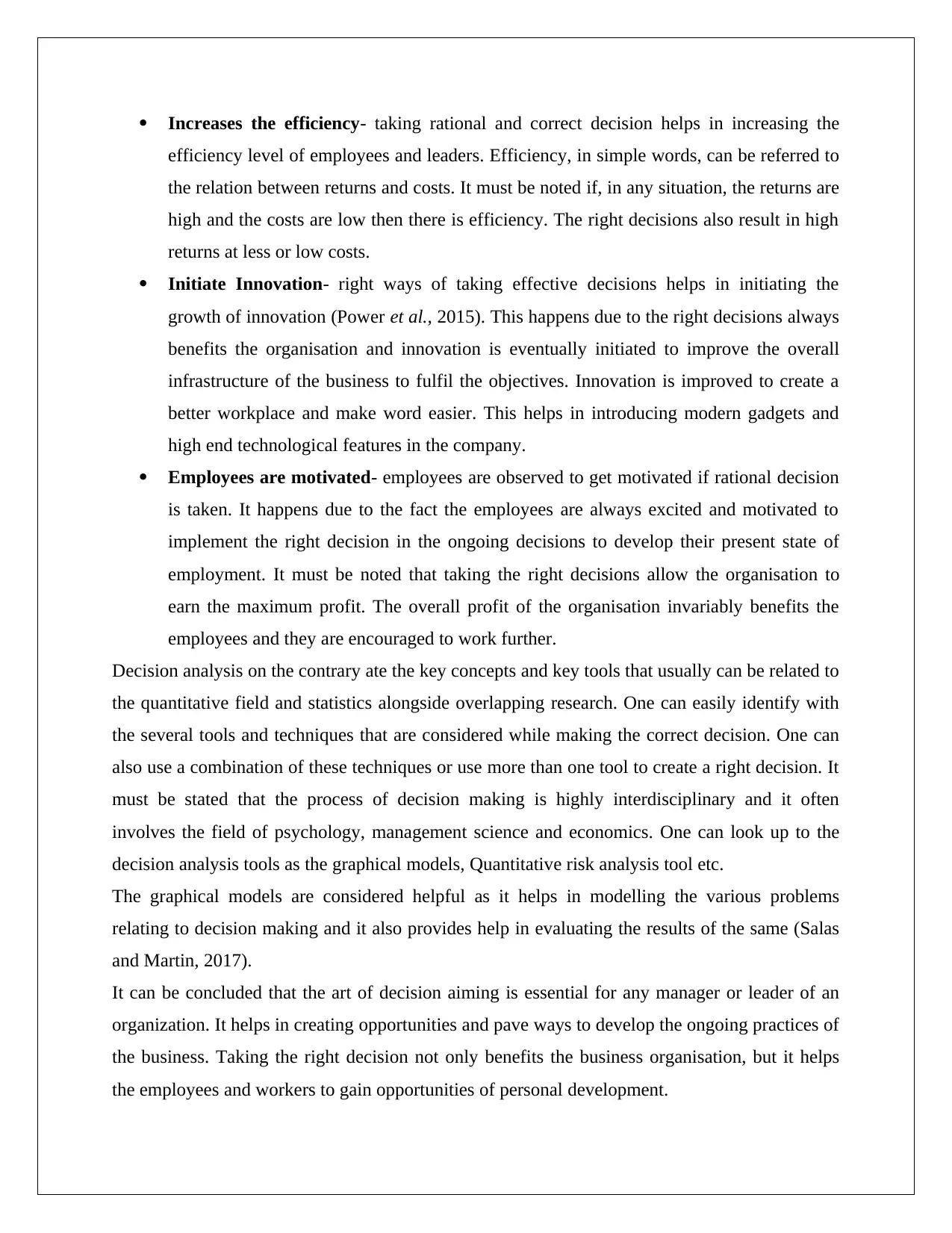
Increases the efficiency- taking rational and correct decision helps in increasing the
efficiency level of employees and leaders. Efficiency, in simple words, can be referred to
the relation between returns and costs. It must be noted if, in any situation, the returns are
high and the costs are low then there is efficiency. The right decisions also result in high
returns at less or low costs.
Initiate Innovation- right ways of taking effective decisions helps in initiating the
growth of innovation (Power et al., 2015). This happens due to the right decisions always
benefits the organisation and innovation is eventually initiated to improve the overall
infrastructure of the business to fulfil the objectives. Innovation is improved to create a
better workplace and make word easier. This helps in introducing modern gadgets and
high end technological features in the company.
Employees are motivated- employees are observed to get motivated if rational decision
is taken. It happens due to the fact the employees are always excited and motivated to
implement the right decision in the ongoing decisions to develop their present state of
employment. It must be noted that taking the right decisions allow the organisation to
earn the maximum profit. The overall profit of the organisation invariably benefits the
employees and they are encouraged to work further.
Decision analysis on the contrary ate the key concepts and key tools that usually can be related to
the quantitative field and statistics alongside overlapping research. One can easily identify with
the several tools and techniques that are considered while making the correct decision. One can
also use a combination of these techniques or use more than one tool to create a right decision. It
must be stated that the process of decision making is highly interdisciplinary and it often
involves the field of psychology, management science and economics. One can look up to the
decision analysis tools as the graphical models, Quantitative risk analysis tool etc.
The graphical models are considered helpful as it helps in modelling the various problems
relating to decision making and it also provides help in evaluating the results of the same (Salas
and Martin, 2017).
It can be concluded that the art of decision aiming is essential for any manager or leader of an
organization. It helps in creating opportunities and pave ways to develop the ongoing practices of
the business. Taking the right decision not only benefits the business organisation, but it helps
the employees and workers to gain opportunities of personal development.
efficiency level of employees and leaders. Efficiency, in simple words, can be referred to
the relation between returns and costs. It must be noted if, in any situation, the returns are
high and the costs are low then there is efficiency. The right decisions also result in high
returns at less or low costs.
Initiate Innovation- right ways of taking effective decisions helps in initiating the
growth of innovation (Power et al., 2015). This happens due to the right decisions always
benefits the organisation and innovation is eventually initiated to improve the overall
infrastructure of the business to fulfil the objectives. Innovation is improved to create a
better workplace and make word easier. This helps in introducing modern gadgets and
high end technological features in the company.
Employees are motivated- employees are observed to get motivated if rational decision
is taken. It happens due to the fact the employees are always excited and motivated to
implement the right decision in the ongoing decisions to develop their present state of
employment. It must be noted that taking the right decisions allow the organisation to
earn the maximum profit. The overall profit of the organisation invariably benefits the
employees and they are encouraged to work further.
Decision analysis on the contrary ate the key concepts and key tools that usually can be related to
the quantitative field and statistics alongside overlapping research. One can easily identify with
the several tools and techniques that are considered while making the correct decision. One can
also use a combination of these techniques or use more than one tool to create a right decision. It
must be stated that the process of decision making is highly interdisciplinary and it often
involves the field of psychology, management science and economics. One can look up to the
decision analysis tools as the graphical models, Quantitative risk analysis tool etc.
The graphical models are considered helpful as it helps in modelling the various problems
relating to decision making and it also provides help in evaluating the results of the same (Salas
and Martin, 2017).
It can be concluded that the art of decision aiming is essential for any manager or leader of an
organization. It helps in creating opportunities and pave ways to develop the ongoing practices of
the business. Taking the right decision not only benefits the business organisation, but it helps
the employees and workers to gain opportunities of personal development.
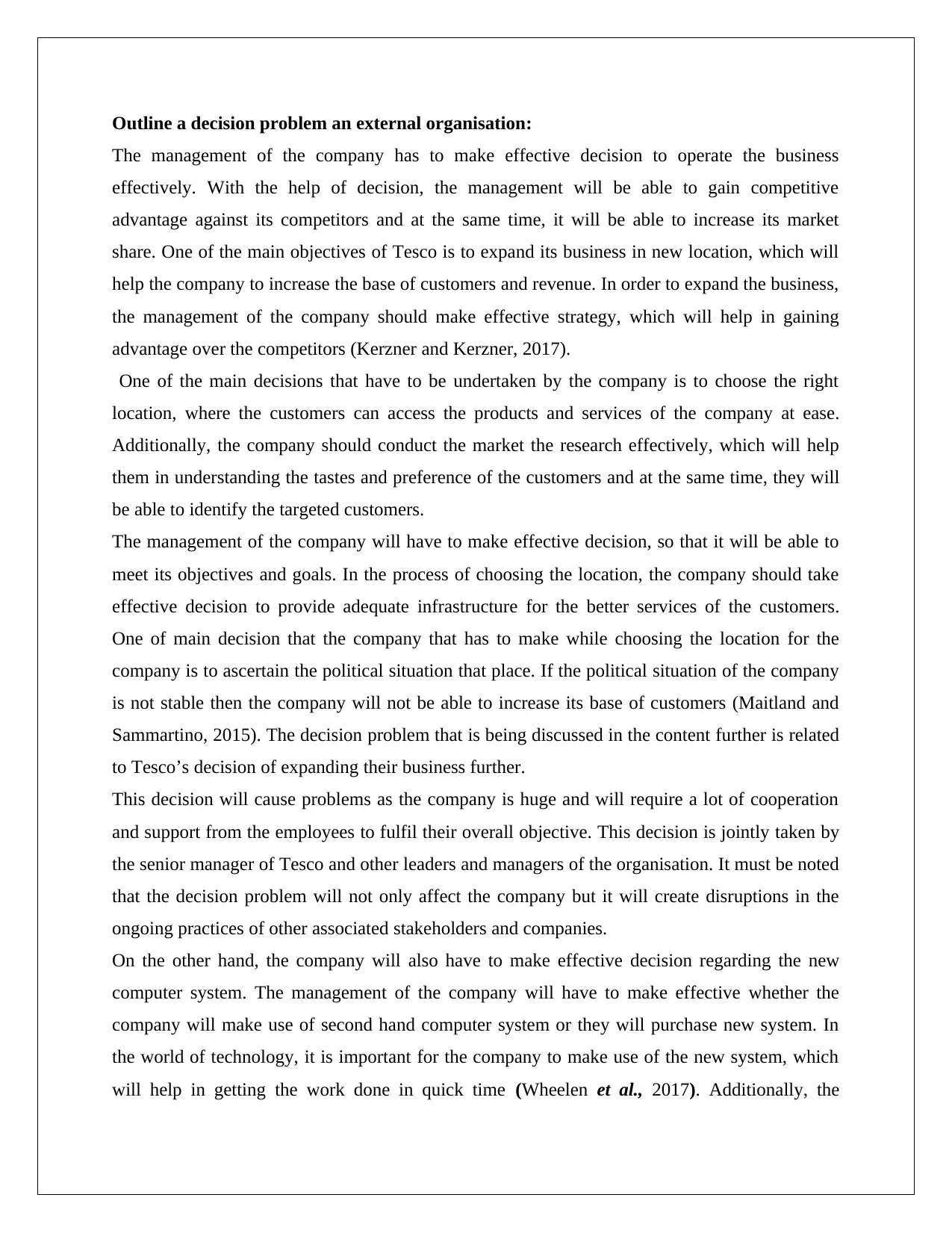
Outline a decision problem an external organisation:
The management of the company has to make effective decision to operate the business
effectively. With the help of decision, the management will be able to gain competitive
advantage against its competitors and at the same time, it will be able to increase its market
share. One of the main objectives of Tesco is to expand its business in new location, which will
help the company to increase the base of customers and revenue. In order to expand the business,
the management of the company should make effective strategy, which will help in gaining
advantage over the competitors (Kerzner and Kerzner, 2017).
One of the main decisions that have to be undertaken by the company is to choose the right
location, where the customers can access the products and services of the company at ease.
Additionally, the company should conduct the market the research effectively, which will help
them in understanding the tastes and preference of the customers and at the same time, they will
be able to identify the targeted customers.
The management of the company will have to make effective decision, so that it will be able to
meet its objectives and goals. In the process of choosing the location, the company should take
effective decision to provide adequate infrastructure for the better services of the customers.
One of main decision that the company that has to make while choosing the location for the
company is to ascertain the political situation that place. If the political situation of the company
is not stable then the company will not be able to increase its base of customers (Maitland and
Sammartino, 2015). The decision problem that is being discussed in the content further is related
to Tesco’s decision of expanding their business further.
This decision will cause problems as the company is huge and will require a lot of cooperation
and support from the employees to fulfil their overall objective. This decision is jointly taken by
the senior manager of Tesco and other leaders and managers of the organisation. It must be noted
that the decision problem will not only affect the company but it will create disruptions in the
ongoing practices of other associated stakeholders and companies.
On the other hand, the company will also have to make effective decision regarding the new
computer system. The management of the company will have to make effective whether the
company will make use of second hand computer system or they will purchase new system. In
the world of technology, it is important for the company to make use of the new system, which
will help in getting the work done in quick time (Wheelen et al., 2017). Additionally, the
The management of the company has to make effective decision to operate the business
effectively. With the help of decision, the management will be able to gain competitive
advantage against its competitors and at the same time, it will be able to increase its market
share. One of the main objectives of Tesco is to expand its business in new location, which will
help the company to increase the base of customers and revenue. In order to expand the business,
the management of the company should make effective strategy, which will help in gaining
advantage over the competitors (Kerzner and Kerzner, 2017).
One of the main decisions that have to be undertaken by the company is to choose the right
location, where the customers can access the products and services of the company at ease.
Additionally, the company should conduct the market the research effectively, which will help
them in understanding the tastes and preference of the customers and at the same time, they will
be able to identify the targeted customers.
The management of the company will have to make effective decision, so that it will be able to
meet its objectives and goals. In the process of choosing the location, the company should take
effective decision to provide adequate infrastructure for the better services of the customers.
One of main decision that the company that has to make while choosing the location for the
company is to ascertain the political situation that place. If the political situation of the company
is not stable then the company will not be able to increase its base of customers (Maitland and
Sammartino, 2015). The decision problem that is being discussed in the content further is related
to Tesco’s decision of expanding their business further.
This decision will cause problems as the company is huge and will require a lot of cooperation
and support from the employees to fulfil their overall objective. This decision is jointly taken by
the senior manager of Tesco and other leaders and managers of the organisation. It must be noted
that the decision problem will not only affect the company but it will create disruptions in the
ongoing practices of other associated stakeholders and companies.
On the other hand, the company will also have to make effective decision regarding the new
computer system. The management of the company will have to make effective whether the
company will make use of second hand computer system or they will purchase new system. In
the world of technology, it is important for the company to make use of the new system, which
will help in getting the work done in quick time (Wheelen et al., 2017). Additionally, the
⊘ This is a preview!⊘
Do you want full access?
Subscribe today to unlock all pages.

Trusted by 1+ million students worldwide
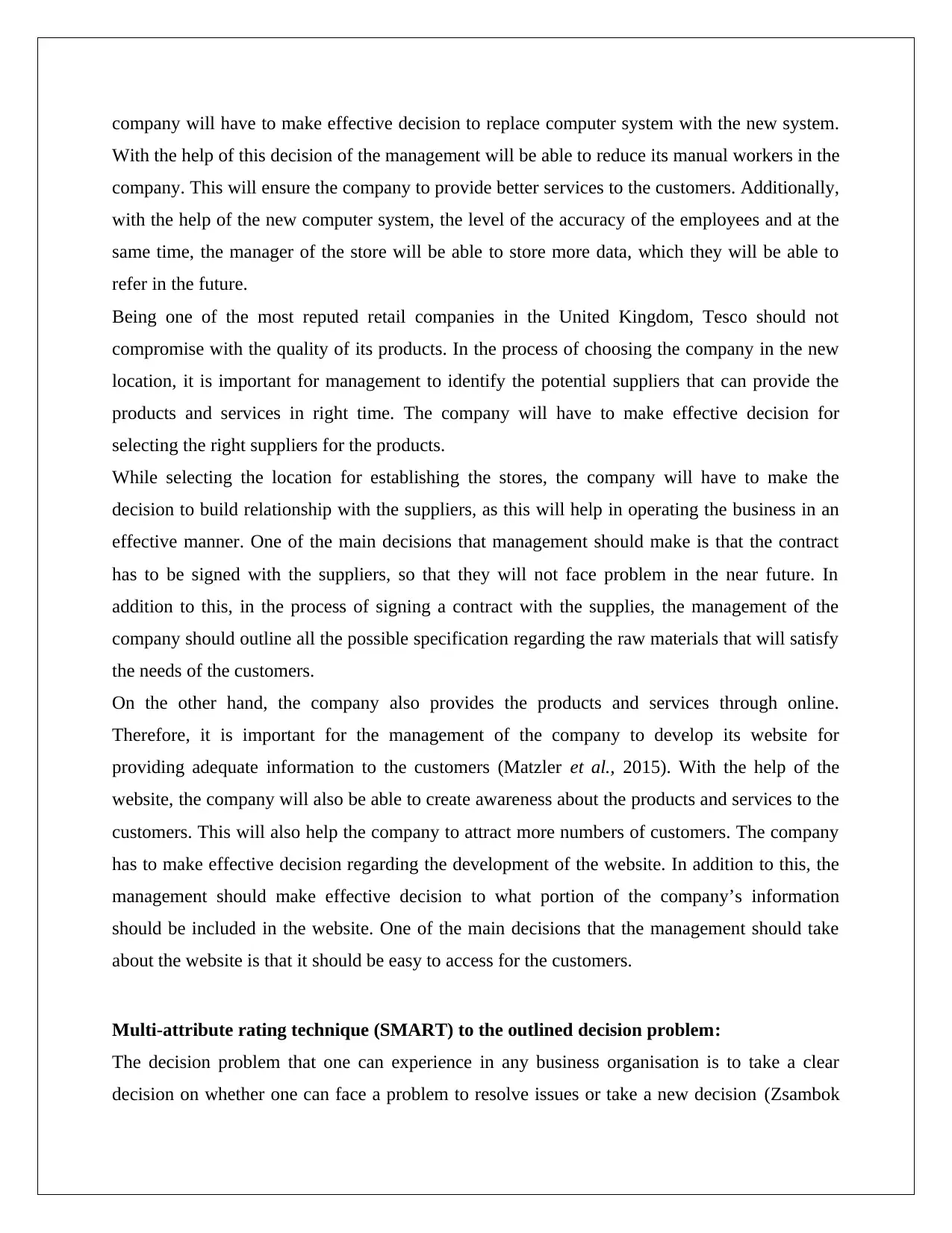
company will have to make effective decision to replace computer system with the new system.
With the help of this decision of the management will be able to reduce its manual workers in the
company. This will ensure the company to provide better services to the customers. Additionally,
with the help of the new computer system, the level of the accuracy of the employees and at the
same time, the manager of the store will be able to store more data, which they will be able to
refer in the future.
Being one of the most reputed retail companies in the United Kingdom, Tesco should not
compromise with the quality of its products. In the process of choosing the company in the new
location, it is important for management to identify the potential suppliers that can provide the
products and services in right time. The company will have to make effective decision for
selecting the right suppliers for the products.
While selecting the location for establishing the stores, the company will have to make the
decision to build relationship with the suppliers, as this will help in operating the business in an
effective manner. One of the main decisions that management should make is that the contract
has to be signed with the suppliers, so that they will not face problem in the near future. In
addition to this, in the process of signing a contract with the supplies, the management of the
company should outline all the possible specification regarding the raw materials that will satisfy
the needs of the customers.
On the other hand, the company also provides the products and services through online.
Therefore, it is important for the management of the company to develop its website for
providing adequate information to the customers (Matzler et al., 2015). With the help of the
website, the company will also be able to create awareness about the products and services to the
customers. This will also help the company to attract more numbers of customers. The company
has to make effective decision regarding the development of the website. In addition to this, the
management should make effective decision to what portion of the company’s information
should be included in the website. One of the main decisions that the management should take
about the website is that it should be easy to access for the customers.
Multi-attribute rating technique (SMART) to the outlined decision problem:
The decision problem that one can experience in any business organisation is to take a clear
decision on whether one can face a problem to resolve issues or take a new decision (Zsambok
With the help of this decision of the management will be able to reduce its manual workers in the
company. This will ensure the company to provide better services to the customers. Additionally,
with the help of the new computer system, the level of the accuracy of the employees and at the
same time, the manager of the store will be able to store more data, which they will be able to
refer in the future.
Being one of the most reputed retail companies in the United Kingdom, Tesco should not
compromise with the quality of its products. In the process of choosing the company in the new
location, it is important for management to identify the potential suppliers that can provide the
products and services in right time. The company will have to make effective decision for
selecting the right suppliers for the products.
While selecting the location for establishing the stores, the company will have to make the
decision to build relationship with the suppliers, as this will help in operating the business in an
effective manner. One of the main decisions that management should make is that the contract
has to be signed with the suppliers, so that they will not face problem in the near future. In
addition to this, in the process of signing a contract with the supplies, the management of the
company should outline all the possible specification regarding the raw materials that will satisfy
the needs of the customers.
On the other hand, the company also provides the products and services through online.
Therefore, it is important for the management of the company to develop its website for
providing adequate information to the customers (Matzler et al., 2015). With the help of the
website, the company will also be able to create awareness about the products and services to the
customers. This will also help the company to attract more numbers of customers. The company
has to make effective decision regarding the development of the website. In addition to this, the
management should make effective decision to what portion of the company’s information
should be included in the website. One of the main decisions that the management should take
about the website is that it should be easy to access for the customers.
Multi-attribute rating technique (SMART) to the outlined decision problem:
The decision problem that one can experience in any business organisation is to take a clear
decision on whether one can face a problem to resolve issues or take a new decision (Zsambok
Paraphrase This Document
Need a fresh take? Get an instant paraphrase of this document with our AI Paraphraser
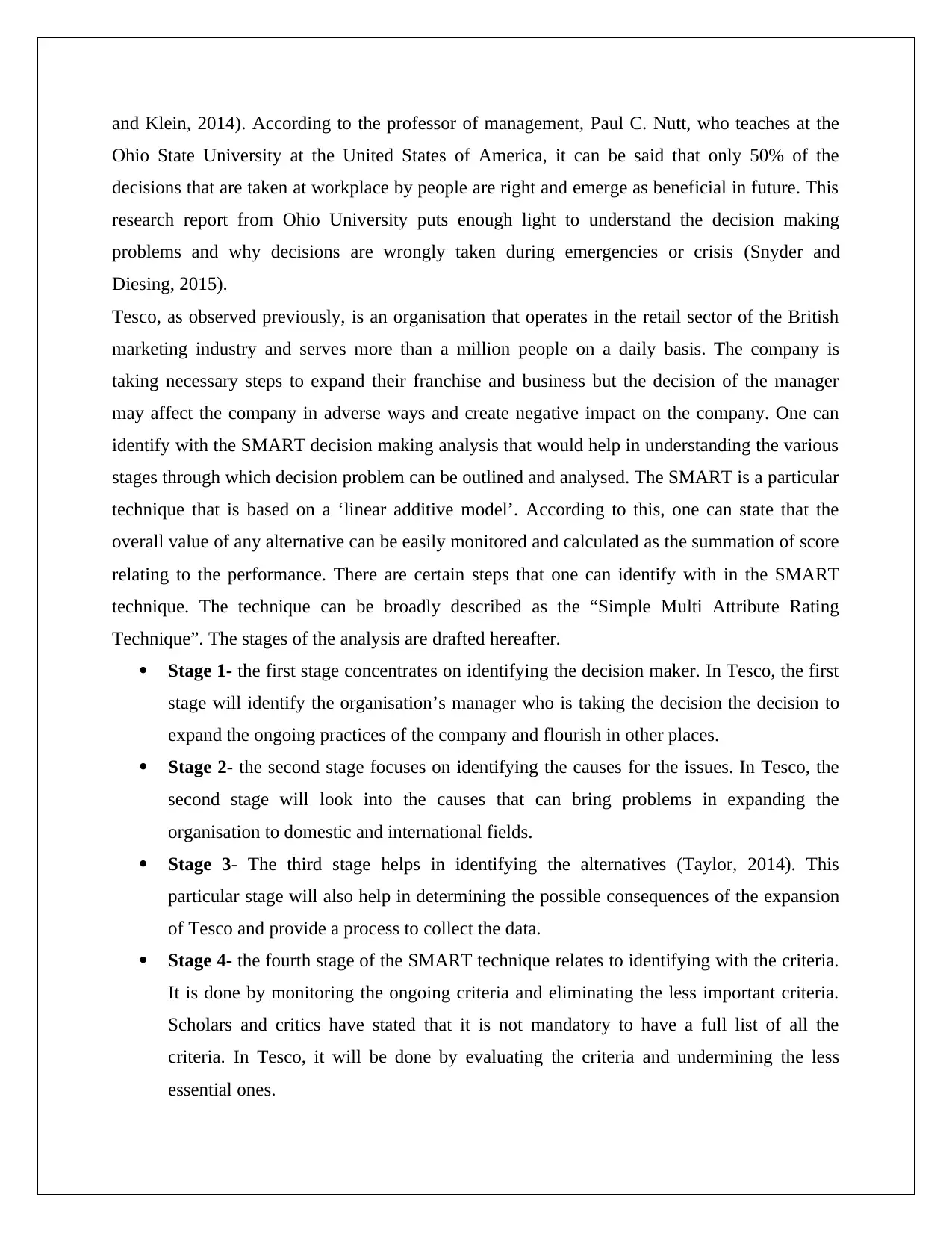
and Klein, 2014). According to the professor of management, Paul C. Nutt, who teaches at the
Ohio State University at the United States of America, it can be said that only 50% of the
decisions that are taken at workplace by people are right and emerge as beneficial in future. This
research report from Ohio University puts enough light to understand the decision making
problems and why decisions are wrongly taken during emergencies or crisis (Snyder and
Diesing, 2015).
Tesco, as observed previously, is an organisation that operates in the retail sector of the British
marketing industry and serves more than a million people on a daily basis. The company is
taking necessary steps to expand their franchise and business but the decision of the manager
may affect the company in adverse ways and create negative impact on the company. One can
identify with the SMART decision making analysis that would help in understanding the various
stages through which decision problem can be outlined and analysed. The SMART is a particular
technique that is based on a ‘linear additive model’. According to this, one can state that the
overall value of any alternative can be easily monitored and calculated as the summation of score
relating to the performance. There are certain steps that one can identify with in the SMART
technique. The technique can be broadly described as the “Simple Multi Attribute Rating
Technique”. The stages of the analysis are drafted hereafter.
Stage 1- the first stage concentrates on identifying the decision maker. In Tesco, the first
stage will identify the organisation’s manager who is taking the decision the decision to
expand the ongoing practices of the company and flourish in other places.
Stage 2- the second stage focuses on identifying the causes for the issues. In Tesco, the
second stage will look into the causes that can bring problems in expanding the
organisation to domestic and international fields.
Stage 3- The third stage helps in identifying the alternatives (Taylor, 2014). This
particular stage will also help in determining the possible consequences of the expansion
of Tesco and provide a process to collect the data.
Stage 4- the fourth stage of the SMART technique relates to identifying with the criteria.
It is done by monitoring the ongoing criteria and eliminating the less important criteria.
Scholars and critics have stated that it is not mandatory to have a full list of all the
criteria. In Tesco, it will be done by evaluating the criteria and undermining the less
essential ones.
Ohio State University at the United States of America, it can be said that only 50% of the
decisions that are taken at workplace by people are right and emerge as beneficial in future. This
research report from Ohio University puts enough light to understand the decision making
problems and why decisions are wrongly taken during emergencies or crisis (Snyder and
Diesing, 2015).
Tesco, as observed previously, is an organisation that operates in the retail sector of the British
marketing industry and serves more than a million people on a daily basis. The company is
taking necessary steps to expand their franchise and business but the decision of the manager
may affect the company in adverse ways and create negative impact on the company. One can
identify with the SMART decision making analysis that would help in understanding the various
stages through which decision problem can be outlined and analysed. The SMART is a particular
technique that is based on a ‘linear additive model’. According to this, one can state that the
overall value of any alternative can be easily monitored and calculated as the summation of score
relating to the performance. There are certain steps that one can identify with in the SMART
technique. The technique can be broadly described as the “Simple Multi Attribute Rating
Technique”. The stages of the analysis are drafted hereafter.
Stage 1- the first stage concentrates on identifying the decision maker. In Tesco, the first
stage will identify the organisation’s manager who is taking the decision the decision to
expand the ongoing practices of the company and flourish in other places.
Stage 2- the second stage focuses on identifying the causes for the issues. In Tesco, the
second stage will look into the causes that can bring problems in expanding the
organisation to domestic and international fields.
Stage 3- The third stage helps in identifying the alternatives (Taylor, 2014). This
particular stage will also help in determining the possible consequences of the expansion
of Tesco and provide a process to collect the data.
Stage 4- the fourth stage of the SMART technique relates to identifying with the criteria.
It is done by monitoring the ongoing criteria and eliminating the less important criteria.
Scholars and critics have stated that it is not mandatory to have a full list of all the
criteria. In Tesco, it will be done by evaluating the criteria and undermining the less
essential ones.
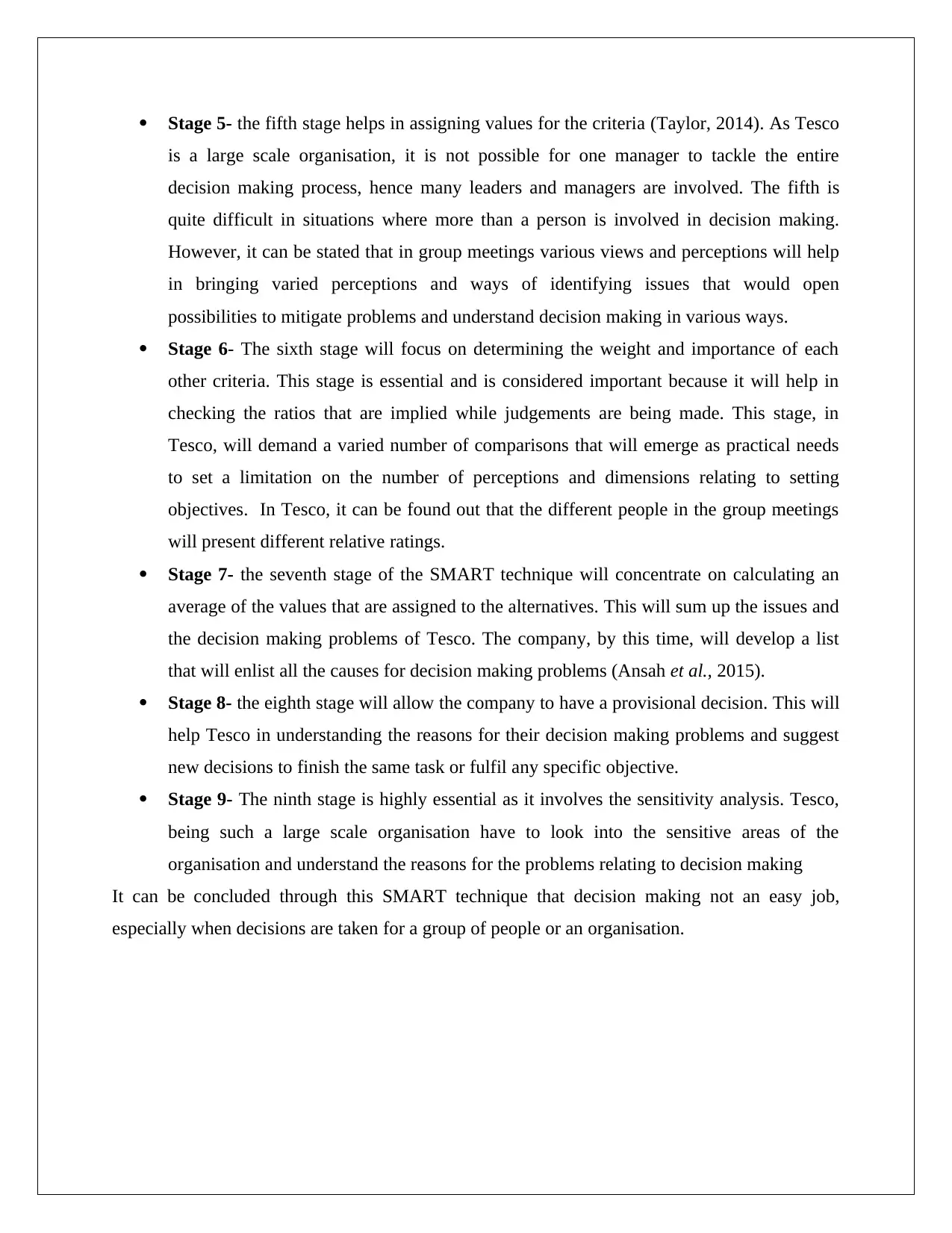
Stage 5- the fifth stage helps in assigning values for the criteria (Taylor, 2014). As Tesco
is a large scale organisation, it is not possible for one manager to tackle the entire
decision making process, hence many leaders and managers are involved. The fifth is
quite difficult in situations where more than a person is involved in decision making.
However, it can be stated that in group meetings various views and perceptions will help
in bringing varied perceptions and ways of identifying issues that would open
possibilities to mitigate problems and understand decision making in various ways.
Stage 6- The sixth stage will focus on determining the weight and importance of each
other criteria. This stage is essential and is considered important because it will help in
checking the ratios that are implied while judgements are being made. This stage, in
Tesco, will demand a varied number of comparisons that will emerge as practical needs
to set a limitation on the number of perceptions and dimensions relating to setting
objectives. In Tesco, it can be found out that the different people in the group meetings
will present different relative ratings.
Stage 7- the seventh stage of the SMART technique will concentrate on calculating an
average of the values that are assigned to the alternatives. This will sum up the issues and
the decision making problems of Tesco. The company, by this time, will develop a list
that will enlist all the causes for decision making problems (Ansah et al., 2015).
Stage 8- the eighth stage will allow the company to have a provisional decision. This will
help Tesco in understanding the reasons for their decision making problems and suggest
new decisions to finish the same task or fulfil any specific objective.
Stage 9- The ninth stage is highly essential as it involves the sensitivity analysis. Tesco,
being such a large scale organisation have to look into the sensitive areas of the
organisation and understand the reasons for the problems relating to decision making
It can be concluded through this SMART technique that decision making not an easy job,
especially when decisions are taken for a group of people or an organisation.
is a large scale organisation, it is not possible for one manager to tackle the entire
decision making process, hence many leaders and managers are involved. The fifth is
quite difficult in situations where more than a person is involved in decision making.
However, it can be stated that in group meetings various views and perceptions will help
in bringing varied perceptions and ways of identifying issues that would open
possibilities to mitigate problems and understand decision making in various ways.
Stage 6- The sixth stage will focus on determining the weight and importance of each
other criteria. This stage is essential and is considered important because it will help in
checking the ratios that are implied while judgements are being made. This stage, in
Tesco, will demand a varied number of comparisons that will emerge as practical needs
to set a limitation on the number of perceptions and dimensions relating to setting
objectives. In Tesco, it can be found out that the different people in the group meetings
will present different relative ratings.
Stage 7- the seventh stage of the SMART technique will concentrate on calculating an
average of the values that are assigned to the alternatives. This will sum up the issues and
the decision making problems of Tesco. The company, by this time, will develop a list
that will enlist all the causes for decision making problems (Ansah et al., 2015).
Stage 8- the eighth stage will allow the company to have a provisional decision. This will
help Tesco in understanding the reasons for their decision making problems and suggest
new decisions to finish the same task or fulfil any specific objective.
Stage 9- The ninth stage is highly essential as it involves the sensitivity analysis. Tesco,
being such a large scale organisation have to look into the sensitive areas of the
organisation and understand the reasons for the problems relating to decision making
It can be concluded through this SMART technique that decision making not an easy job,
especially when decisions are taken for a group of people or an organisation.
⊘ This is a preview!⊘
Do you want full access?
Subscribe today to unlock all pages.

Trusted by 1+ million students worldwide
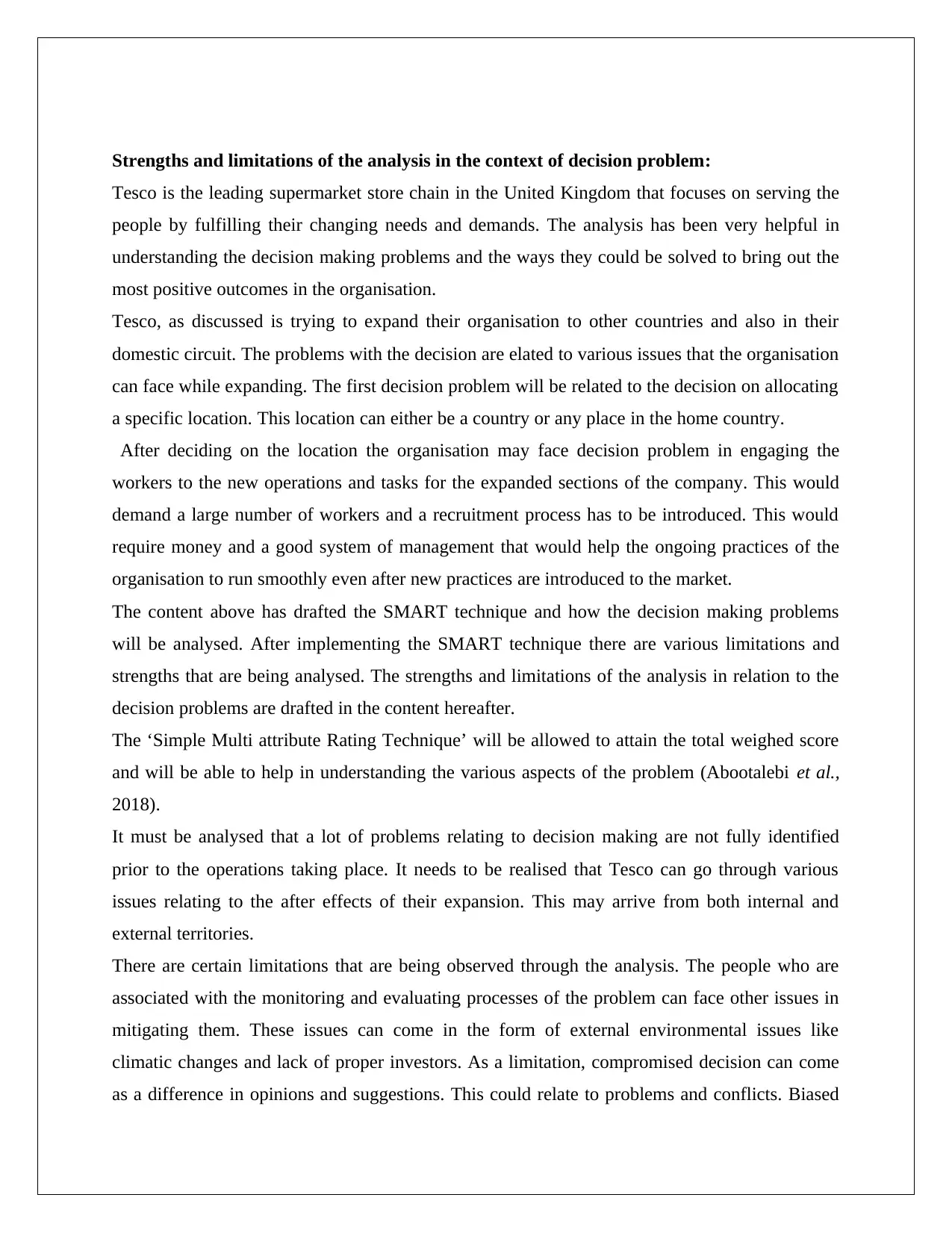
Strengths and limitations of the analysis in the context of decision problem:
Tesco is the leading supermarket store chain in the United Kingdom that focuses on serving the
people by fulfilling their changing needs and demands. The analysis has been very helpful in
understanding the decision making problems and the ways they could be solved to bring out the
most positive outcomes in the organisation.
Tesco, as discussed is trying to expand their organisation to other countries and also in their
domestic circuit. The problems with the decision are elated to various issues that the organisation
can face while expanding. The first decision problem will be related to the decision on allocating
a specific location. This location can either be a country or any place in the home country.
After deciding on the location the organisation may face decision problem in engaging the
workers to the new operations and tasks for the expanded sections of the company. This would
demand a large number of workers and a recruitment process has to be introduced. This would
require money and a good system of management that would help the ongoing practices of the
organisation to run smoothly even after new practices are introduced to the market.
The content above has drafted the SMART technique and how the decision making problems
will be analysed. After implementing the SMART technique there are various limitations and
strengths that are being analysed. The strengths and limitations of the analysis in relation to the
decision problems are drafted in the content hereafter.
The ‘Simple Multi attribute Rating Technique’ will be allowed to attain the total weighed score
and will be able to help in understanding the various aspects of the problem (Abootalebi et al.,
2018).
It must be analysed that a lot of problems relating to decision making are not fully identified
prior to the operations taking place. It needs to be realised that Tesco can go through various
issues relating to the after effects of their expansion. This may arrive from both internal and
external territories.
There are certain limitations that are being observed through the analysis. The people who are
associated with the monitoring and evaluating processes of the problem can face other issues in
mitigating them. These issues can come in the form of external environmental issues like
climatic changes and lack of proper investors. As a limitation, compromised decision can come
as a difference in opinions and suggestions. This could relate to problems and conflicts. Biased
Tesco is the leading supermarket store chain in the United Kingdom that focuses on serving the
people by fulfilling their changing needs and demands. The analysis has been very helpful in
understanding the decision making problems and the ways they could be solved to bring out the
most positive outcomes in the organisation.
Tesco, as discussed is trying to expand their organisation to other countries and also in their
domestic circuit. The problems with the decision are elated to various issues that the organisation
can face while expanding. The first decision problem will be related to the decision on allocating
a specific location. This location can either be a country or any place in the home country.
After deciding on the location the organisation may face decision problem in engaging the
workers to the new operations and tasks for the expanded sections of the company. This would
demand a large number of workers and a recruitment process has to be introduced. This would
require money and a good system of management that would help the ongoing practices of the
organisation to run smoothly even after new practices are introduced to the market.
The content above has drafted the SMART technique and how the decision making problems
will be analysed. After implementing the SMART technique there are various limitations and
strengths that are being analysed. The strengths and limitations of the analysis in relation to the
decision problems are drafted in the content hereafter.
The ‘Simple Multi attribute Rating Technique’ will be allowed to attain the total weighed score
and will be able to help in understanding the various aspects of the problem (Abootalebi et al.,
2018).
It must be analysed that a lot of problems relating to decision making are not fully identified
prior to the operations taking place. It needs to be realised that Tesco can go through various
issues relating to the after effects of their expansion. This may arrive from both internal and
external territories.
There are certain limitations that are being observed through the analysis. The people who are
associated with the monitoring and evaluating processes of the problem can face other issues in
mitigating them. These issues can come in the form of external environmental issues like
climatic changes and lack of proper investors. As a limitation, compromised decision can come
as a difference in opinions and suggestions. This could relate to problems and conflicts. Biased
Paraphrase This Document
Need a fresh take? Get an instant paraphrase of this document with our AI Paraphraser
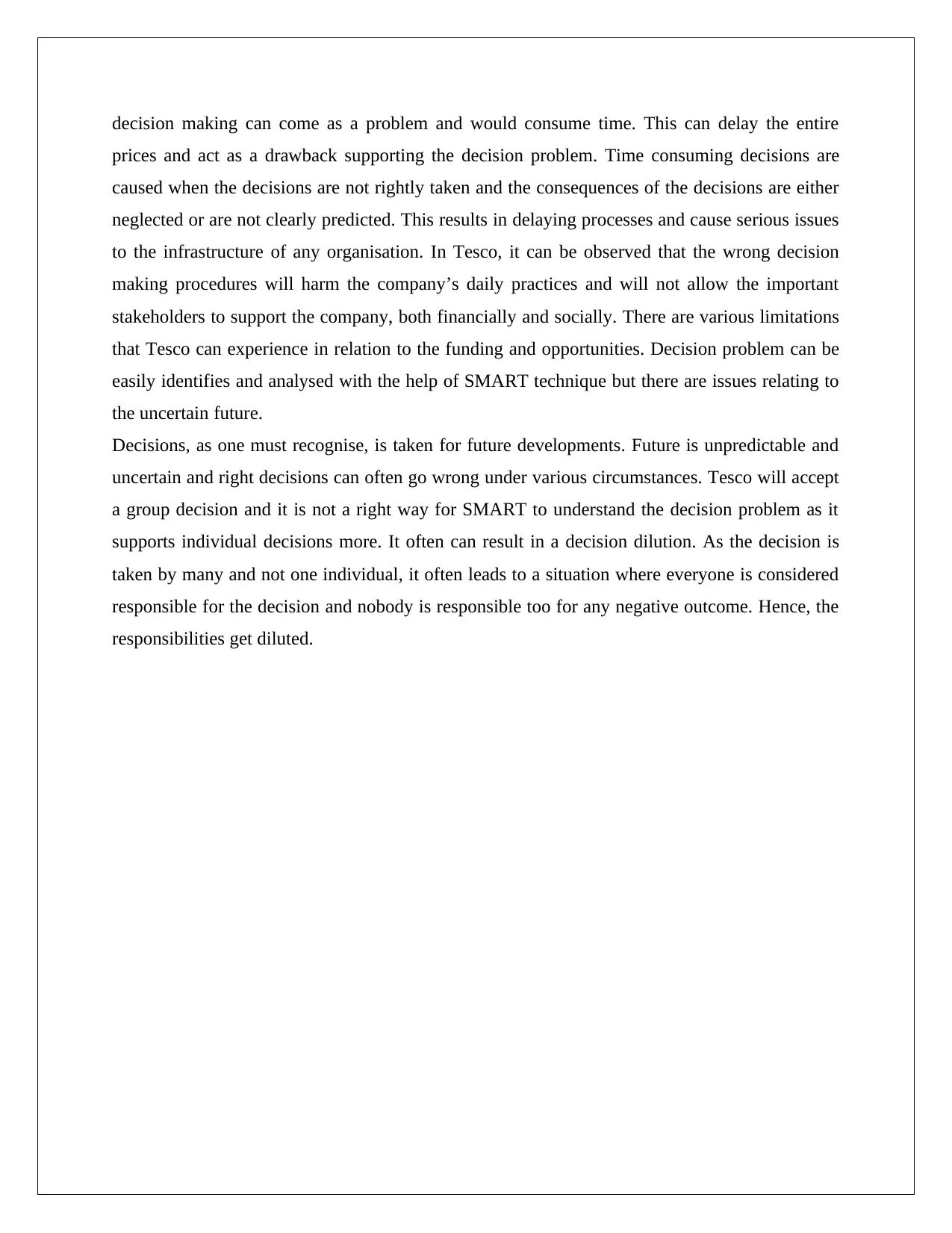
decision making can come as a problem and would consume time. This can delay the entire
prices and act as a drawback supporting the decision problem. Time consuming decisions are
caused when the decisions are not rightly taken and the consequences of the decisions are either
neglected or are not clearly predicted. This results in delaying processes and cause serious issues
to the infrastructure of any organisation. In Tesco, it can be observed that the wrong decision
making procedures will harm the company’s daily practices and will not allow the important
stakeholders to support the company, both financially and socially. There are various limitations
that Tesco can experience in relation to the funding and opportunities. Decision problem can be
easily identifies and analysed with the help of SMART technique but there are issues relating to
the uncertain future.
Decisions, as one must recognise, is taken for future developments. Future is unpredictable and
uncertain and right decisions can often go wrong under various circumstances. Tesco will accept
a group decision and it is not a right way for SMART to understand the decision problem as it
supports individual decisions more. It often can result in a decision dilution. As the decision is
taken by many and not one individual, it often leads to a situation where everyone is considered
responsible for the decision and nobody is responsible too for any negative outcome. Hence, the
responsibilities get diluted.
prices and act as a drawback supporting the decision problem. Time consuming decisions are
caused when the decisions are not rightly taken and the consequences of the decisions are either
neglected or are not clearly predicted. This results in delaying processes and cause serious issues
to the infrastructure of any organisation. In Tesco, it can be observed that the wrong decision
making procedures will harm the company’s daily practices and will not allow the important
stakeholders to support the company, both financially and socially. There are various limitations
that Tesco can experience in relation to the funding and opportunities. Decision problem can be
easily identifies and analysed with the help of SMART technique but there are issues relating to
the uncertain future.
Decisions, as one must recognise, is taken for future developments. Future is unpredictable and
uncertain and right decisions can often go wrong under various circumstances. Tesco will accept
a group decision and it is not a right way for SMART to understand the decision problem as it
supports individual decisions more. It often can result in a decision dilution. As the decision is
taken by many and not one individual, it often leads to a situation where everyone is considered
responsible for the decision and nobody is responsible too for any negative outcome. Hence, the
responsibilities get diluted.
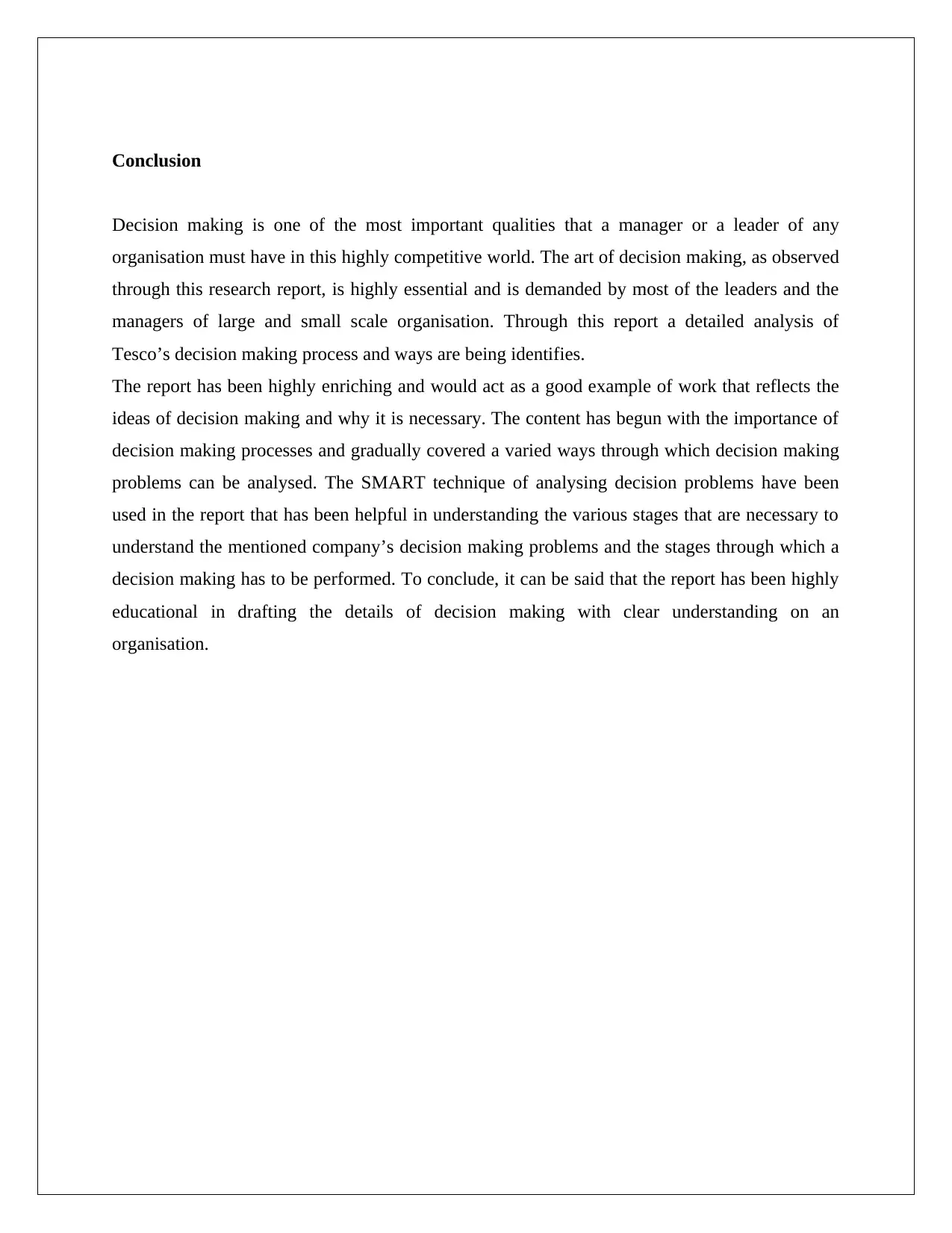
Conclusion
Decision making is one of the most important qualities that a manager or a leader of any
organisation must have in this highly competitive world. The art of decision making, as observed
through this research report, is highly essential and is demanded by most of the leaders and the
managers of large and small scale organisation. Through this report a detailed analysis of
Tesco’s decision making process and ways are being identifies.
The report has been highly enriching and would act as a good example of work that reflects the
ideas of decision making and why it is necessary. The content has begun with the importance of
decision making processes and gradually covered a varied ways through which decision making
problems can be analysed. The SMART technique of analysing decision problems have been
used in the report that has been helpful in understanding the various stages that are necessary to
understand the mentioned company’s decision making problems and the stages through which a
decision making has to be performed. To conclude, it can be said that the report has been highly
educational in drafting the details of decision making with clear understanding on an
organisation.
Decision making is one of the most important qualities that a manager or a leader of any
organisation must have in this highly competitive world. The art of decision making, as observed
through this research report, is highly essential and is demanded by most of the leaders and the
managers of large and small scale organisation. Through this report a detailed analysis of
Tesco’s decision making process and ways are being identifies.
The report has been highly enriching and would act as a good example of work that reflects the
ideas of decision making and why it is necessary. The content has begun with the importance of
decision making processes and gradually covered a varied ways through which decision making
problems can be analysed. The SMART technique of analysing decision problems have been
used in the report that has been helpful in understanding the various stages that are necessary to
understand the mentioned company’s decision making problems and the stages through which a
decision making has to be performed. To conclude, it can be said that the report has been highly
educational in drafting the details of decision making with clear understanding on an
organisation.
⊘ This is a preview!⊘
Do you want full access?
Subscribe today to unlock all pages.

Trusted by 1+ million students worldwide
1 out of 14
Related Documents
Your All-in-One AI-Powered Toolkit for Academic Success.
+13062052269
info@desklib.com
Available 24*7 on WhatsApp / Email
![[object Object]](/_next/static/media/star-bottom.7253800d.svg)
Unlock your academic potential
Copyright © 2020–2025 A2Z Services. All Rights Reserved. Developed and managed by ZUCOL.





